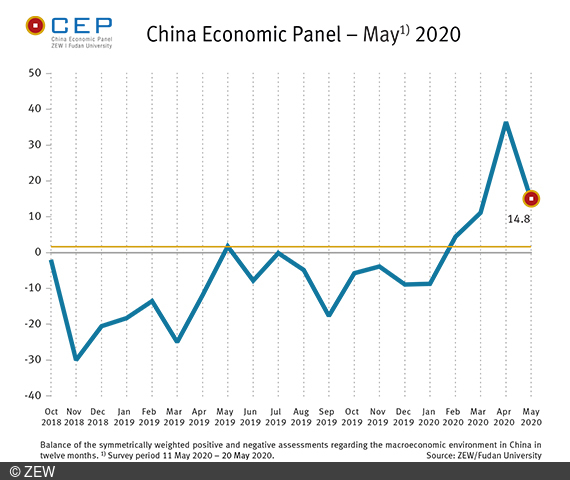Decline in Expectations Reveals Persistent Uncertainty
China Economic PanelCEP indicator stands at 14.8 points
In the current May survey (11–20 May 2020), the CEP indicator falls by 21.7 points to a value of 14.8 points, largely reversing last month’s 25.4-point increase. The CEP indicator, based on the China Economic Panel (CEP) in cooperation with Fudan University, Shanghai, reflects the economic expectations of international financial market experts for China on a 12-month basis.
“The strong fluctuations of the CEP indicator observed in recent months show that experts are currently very uncertain about the future development of the Chinese economy,” says Dr. Michael Schröder, project manager of the CEP survey and senior researcher in the ZEW Research Department “International Finance and Financial Management”.
The forecasts for real gross domestic product (GDP) were again revised downwards. The average growth forecast for the second quarter of 2020 is currently only 0.5 per cent, after growth projections were still at 2.0 per cent in April. The forecast for the third quarter of 2020 was lowered from 4.2 per cent to 3.5 per cent. Although the experts still expect to see a turnaround in economic development this summer, growth levels are lower than originally projected. For the entire year of 2020, the survey experts are forecasting real GDP growth of only 2.1 per cent (previous month: 3.4 per cent).
“According to the experts, such a growth level, which is very low by Chinese standards, can only be achieved by a further significant increase in debt and government consumption. In contrast to private consumption and private investment, both of which are still considered to be quite weak, the government sector is set to become more and more a driving force of economic development,” says Michael Schröder.
The fairly pessimistic outlook for economic development in the coming months is also reflected at the sector level and in the forecasts for China’s key economic regions. Expectations regarding the development of real estate prices have also become largely negative.
